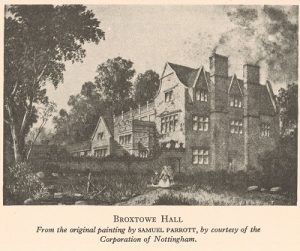October 6, 2021, by Kathryn Summerwill
Beyond the Mayflower: Separatists and Puritans
Our new exhibition ‘Beyond the Mayflower’ is now open at the Weston Gallery, Lakeside Arts. Among the passengers on the sailing of the Mayflower in 1620 were a group of religious separatists who wished to worship in a different way to that allowed by the Church of England.

‘Exiled Nonconformists landing in America’, from Cassell’s illustrated history of England Vol III. [c.1864], p.373. East Midlands Special Collection Not 1.W8 HOW/W
The Archdeaconry of Nottingham Archive
Between 2002 and 2004, a project to conserve and catalogue over 23,000 original Archdeaconry of Nottingham presentment bills dated between 1587 and 1699 was supported by the Heritage Lottery Fund. The presentment bills were made out by the churchwardens of each parish twice a year, and contain reports of the offences against church law carried out by ordinary people.
‘Beyond the Mayflower’ includes court records of cases brought against key figures in the Separatist movement of the early 1600s. William Brewster hosted an illegal congregation led by the preacher John Robinson in his manor house at Scrooby. Thomas Helwys of Broxtowe Hall was a supporter of a similar church led by John Smyth in Gainsborough. Both groups, feeling persecuted, fled to Holland in 1608. Brewster travelled to America on the Mayflower in 1620 and became a respected elder of the church in the new colony founded in Plymouth, Massachusetts.

Broxtowe Hall, from an original painting by Samuel Parrot, published in WT Whitley, Thomas Helwys of Gray’s Inn and Broxtowe Hall, Nottingham (c.1935), East Midlands Collection, Pamphlet Not 3 V38 HEL)

Presentment Bill against Thomas Helwys, signed by three churchwardens of Basford, 11 April 1608. Archive of the Archdeaconry of Nottingham, AN/PB 294/2/100
It is clear from the presentment bills that these two groups were only the tip of the iceberg. They were unusual in migrating abroad to try to gain religious freedom. However, many other people held similar views, or wished to reform the Church of England from within. There are clues in the words used to describe the offences which can indicate that the person was a Puritan or a Separatist. They include:
- the wearing of hats in church (considered irreverent by church authorities, although this was disputed by Puritans who often deliberately wore their hats as a protest)
- refusal to kneel in church
- questioning attitudes, especially over the manner of receiving communion (whether standing or sitting)
- arguments with clergy over specifically religious questions
- attending other churches on Sundays, or hearing visiting preachers outside their own parish
- holding private religious meetings, or ‘conventicles’.
Each presentment bill has been catalogued and indexed using a consistent terminology. Behaviour of this type was indexed using the offence term ‘lay non-conformity’. Presentment bills reporting religious offences survive for the period 1587 to 1643 (with some gaps), and again from 1663 to 1686. There were nearly 700 presentments of people for ‘lay non-conformity’ during this period, and many thousands of others for ‘not attending church’ or ‘not receiving communion’.

Illustration of ‘Arrest of Nonconformists’, from Cassell’s illustrated history of England Vol III. (c.1864), p.54
East Midlands Special Collection, Not 1.W8 HOW/W
A detailed article on the history of Protestant dissent in Nottinghamshire as seen from the presentment bills has recently been published on the Archdeaconry Resources section of our website.
You can search the presentment bills yourself using our Manuscripts Online Catalogue. If you are interested in seeing exactly who was presented for each type of offence, you can use the ‘People search’ function. Scroll down to the field ‘Offence (Archdeaconry records only)’ and choose an offence from the list. Some offences were so common that you would be wise to add a place name as well in the ‘Any text’ field, otherwise you may be overwhelmed with results. You can sort the results into alphabetical order by surname by clicking on the ‘Person Name’ column heading.
Full descriptions of what each of the different Archdeaconry offences cover are available in the Archdeaconry Resources pages of our website.
To accompany the exhibition, there are a series of talks and behind-the-scenes gallery tours. Tickets can be booked through Lakeside Arts Box Office. To see the original archives and rare books, please contact Manuscripts and Special Collections on mss.library@nottingham.ac.uk to make an appointment to visit the Reading Room.
No comments yet, fill out a comment to be the first

Leave a Reply